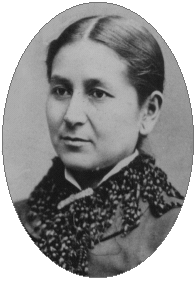|
"Nedawi." An Indian Story from Real Life
by Suzette La Flesche

Suzette La Flesche, was first the
published Native American artist and writer. La Flesche
published this story under the English translation of her
Native American name Inshta Theumba ("Bright Eyes"). This
story though fictional was based on La Flesche's experiences
growing up Native American in Omaha during the age of
incorporation. The story was first published in St. Nicholas
Magazine in 1881. Like Sa's Impressions, Nedawi reveals an
Indian childhood full of innocence and story telling. Yet,
unlike Sa who leaves comparisons between the upbringing of
white and Indian children to her readers, La Flesche makes
these comparisons overtly in her text. Nedawi is "no more
perfect than any little white girl who gets into a temper now
and then." She swings back and forth "pretty much as white
children do." This story of La Flesche's, at this time an
"inmate" at a boarding school for Indian girls, represents the
similarities and argues for the common ground of humanity held
between the white and brown races.
|


